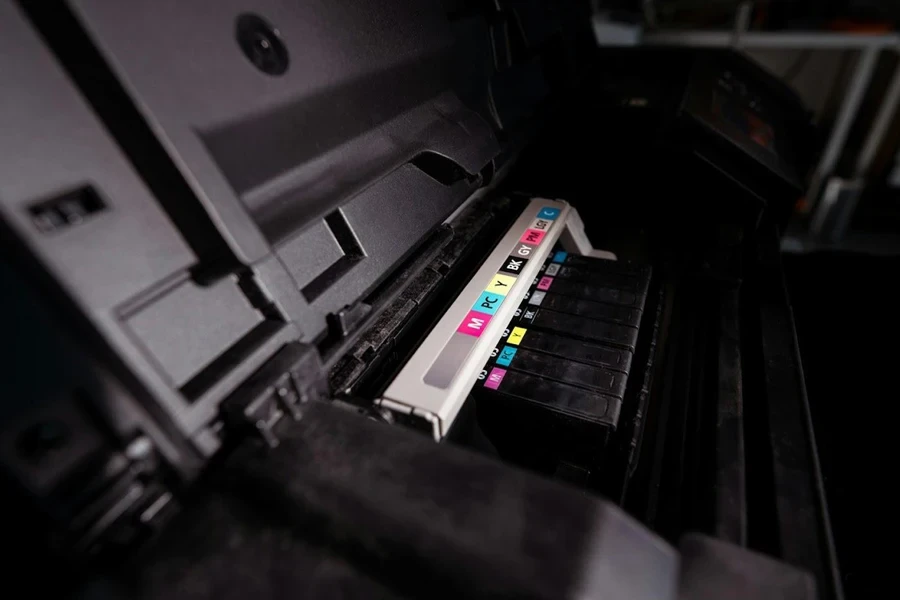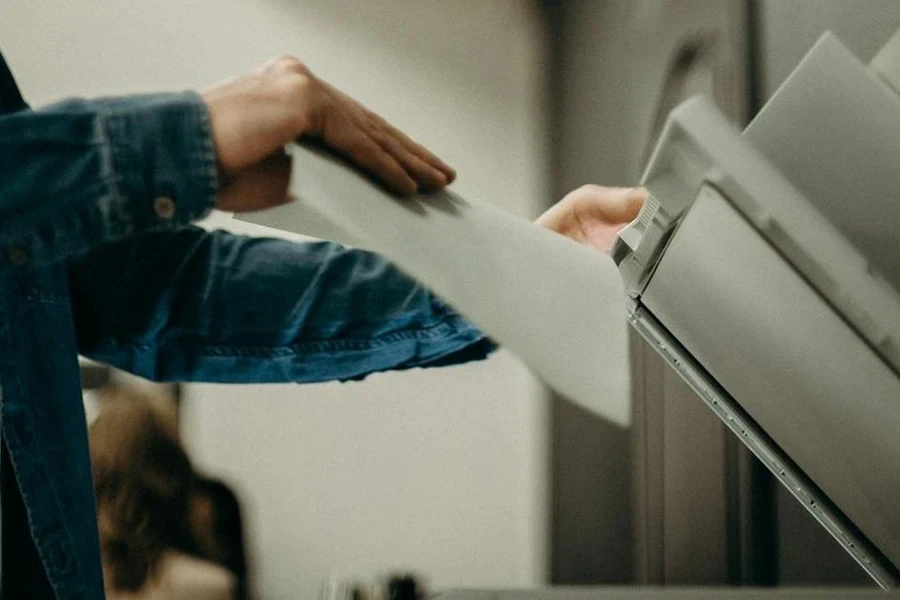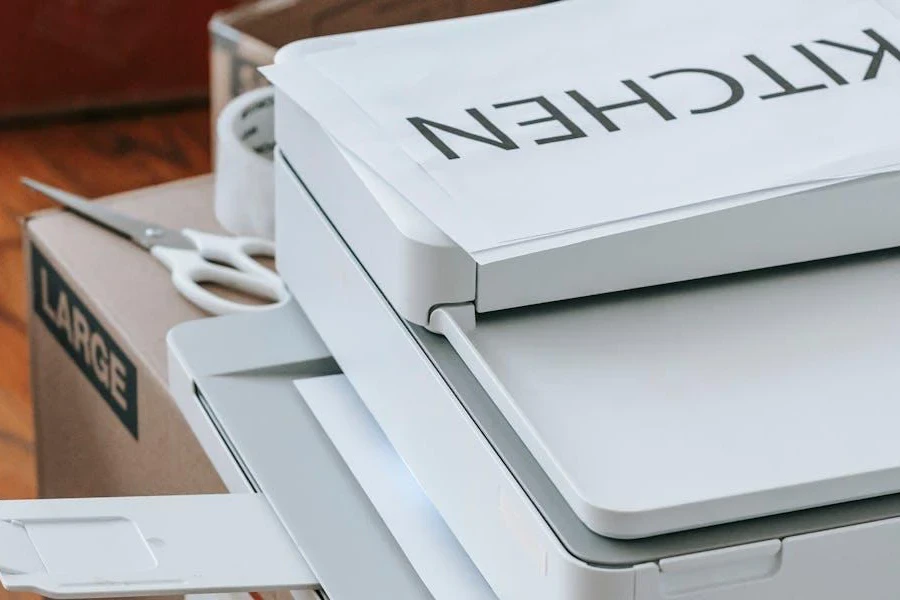Inkjet and laser printers are the two titans of the print world constantly battling for consumers’ attention. Both printer technologies attract different people worldwide and satisfy various printing needs. Still, the question remains: Which technology to stock in 2024?
This inkjet vs. laser printer article will examine all the differences and provide key stats to help retailers choose the more attractive options to sell.
Table of Contents
Is the printer market growing fast in 2024?
What’s an inkjet printer, and how does it work?
What’s a laser printer, and how does it work?
5 differences to consider when choosing between inkjet vs. laser printers
Which is the better option to sell?
Bottom line
Is the printer market growing fast in 2024?
According to Mordor Intelligence, the global printer market grew exponentially to US$ 54.35 billion in 2024. Experts predict the market will grow to US$ 67.88 billion by 2029 at a 4.55% compound annual growth rate (CAGR). Changing customer printing needs, the debut of new technologies, and the expansion of new markets spearhead the printer market’s explosive growth.
What’s an inkjet printer, and how does it work?

As their name implies, inkjet printers function with dye or pigment-based inks. They have small nozzles that release ink droplets on paper when printing.
Inkjet printing is great for brightly colored images and is the go-to for consumers hoping to create high-resolution photos and graphics.
What’s a laser printer, and how does it work?

Laser printers create images and text using toners instead of ink. They are generally larger than inkjets and have impressive print speeds.
These advantages are why laser printers became a top option in the industry, especially for busy offices and larger businesses. Laser printers also have large replacement supply yields, additional capacities, and robust security features.
5 differences to consider when choosing between inkjet vs. laser printers
1. Purpose
Consumers seeking printers of occasional use often consider inkjet printers. They are great for handling small-volume printing of high-resolution images. However, ink can dry up when these printers are inactive.
Laser printers may be more expensive but are well-known for handling large volumes of monochrome and color documents. They also use toners that won’t dry up, making them the perfect choice for irregular use. Even better, laser printers are becoming far more popular for home use, not just offices.
2. Resolution

Print resolution, measured in DPI (dots per inch), determines print sharpness. A printer with 600 DPI will suffice for high-resolution documents, while 1200 DPI is better for color images. High-resolution photo printing is more common with professional inkjet printers, while laser models are the go-to for sharp documents and satisfactory color images.
While higher DPI can improve sharpness, most people don’t need anything beyond 1200 DPI. Customers will choose their printer resolution depending on their needs.
Although people didn’t think much of colored laser printers (because of their resolution), they are now good enough for medium-quality color images, combining reliability and economy. Inkjet printers can reach resolutions up to 9600 x 2400 DPI, while most laser printers offer up to 2400 x 600 DPI, with newer models reaching up to 38,400 x 600 DPI (like the HP Color LaserJet Pro M479fdw)
3. Print speed
Manufacturers create laser printers with businesses in mind, meaning they designed them to handle anything workplaces throw at them. For this reason, they have way faster print speeds than inkjet models. While laser printers can dish out 15 to 100 ppm (pages per minute), inkjet models max out at 16 ppm.
Print volumes refer to how much print a printer can handle at a given time. Laser printers are faster than their inkjet counterparts, allowing them to produce more documents and offer higher monthly print volumes.
Here’s a quick comparison of two popular models: the HP LaserJet Pro M401n and Canon’s inkjet PIXMA TR8620. The table below shows the huge difference between printer technologies.
| HP LaserJet Pro M401n | Canon PIXMA TR8620 | |
| Printer type | Laser | Inkjet |
| Monthly print volume | 750 to 3,000 pages | Less than 1,000 pages |
| Pages per minute | 35 ppm | 15 ppm |
4. Page yield

Toner cartridges for laser printers have a higher page yield than ink cartridges, meaning they will last longer than ink. Typically, ink cartridges print between 135 and 1,000 pages, while toner cartridges range from 2,000 to 10,000. However, ink tank printers, like those from Epson, Canon, and HP, are trying to catch up with ink bottle refills instead of cartridges.
For example, the Epson 522 cyan ink bottle can print about 7,000 pages (an up to 7x improvement). However, ink tank printers can suffer from ink drying and nozzle clogs without regular use.
5. Cost
Laser printers have a higher upfront than inkjet printers, with the cheapest models starting at around US$ 59.99, while some inkjets cost as low as US$ 29.99.
However, cheap inkjets often have high running costs due to cartridges needing frequent replacements. Such a situation leads to maintenance quickly exceeding the printer’s price.
Additionally, inkjet printers typically last about three years, while laser printers can work for a minimum of five years, depending on how consumers use them.
Nevertheless, another crucial factor consumers often consider is the cost per page. Laser toner cartridges, though more expensive upfront, print significantly more pages than inkjets, making them more cost-efficient.
For example, the HP LaserJet M401n’s toner prints 6,900 pages versus 400 pages for the Canon TR8620’s ink cartridge, resulting in a lower cost per page for the laser printer. Here’s another comparison table with more details.
| HP LaserJet Pro M401n | Canon PIXMA TR8620 | |
| Cartridge | HP 80X Black Toner | Canon PCI-280XL Black ink |
| Page yield | 6,900 pages | 400 pages |
| Cost | US$ 227.99 (as of 7/11/2024) | US$ 27.99 (as of 7/11/2024) |
| Cost per Page | 3.1 cents per page | 6.9 cents per page |
Which is the better option to sell?

With all the differences laid out, retailers can pick a few things about who prefers each printer type. Inkjet printers appeal to customers looking for the best resolution. They are also great options for those who don’t mind the low print volume and only need a printer for less frequent needs.
On the other hand, laser printers are more heavy-duty. They will attract large businesses, busy offices, and those with high printing needs. Laser printers are also perfect for printing all kinds of documents and medium-quality colored images.
So, which one will attract more attention in 2024? Here are some Google ad stats with all the juicy details. According to research, interest in inkjet printers dropped by 20% from 60,500 searches in June 2024 to 49,500 in July.
In contrast, laser printers have maintained a steady search interest in 2024. They have attracted 74,000 searches monthly since March 2024 till date (July 2024). Hence, laser printers are attracting more consumer interest than their inkjet counterparts.
Bottom line
Inkjet and lasers have been the focus of the industry for years despite other technologies popping up recently. However, it’s easy to see laser printers still offer better options for everyday use regardless of their high upfront cost. When it comes to which technology attracts more attention, laser printers take the win.
But don’t look down on inkjet printers. They still attract a loyal consumer base, prioritizing quality over quantity.




